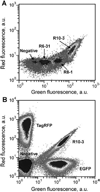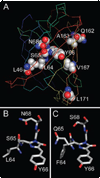The first mutant of the Aequorea victoria green fluorescent protein that forms a red chromophore
- PMID: 18366185
- PMCID: PMC2900791
- DOI: 10.1021/bi702130s
The first mutant of the Aequorea victoria green fluorescent protein that forms a red chromophore
Abstract
Green fluorescent protein (GFP) from a jellyfish, Aequorea victoria, and its mutants are widely used in biomedical studies as fluorescent markers. In spite of the enormous efforts of academia and industry toward generating its red fluorescent mutants, no GFP variants with emission maximum at more than 529 nm have been developed during the 15 years since its cloning. Here, we used a new strategy of molecular evolution aimed at generating a red-emitting mutant of GFP. As a result, we have succeeded in producing the first GFP mutant that substantially matures to the red-emitting state with excitation and emission maxima at 555 and 585 nm, respectively. A novel, nonoxidative mechanism for formation of the red chromophore in this mutant that includes a dehydration of the Ser65 side chain has been proposed. Model experiments showed that the novel dual-color GFP mutant with green and red emission is suitable for multicolor flow cytometry as an additional color since it is clearly separable from both green and red fluorescent tags.
Figures






References
-
- Lippincott-Schwartz J, Patterson GH. Development and use of fluorescent protein markers in living cells. Science. 2003;300:87–91. - PubMed
-
- Verkhusha VV, Lukyanov KA. The molecular properties and applications of Anthozoa fluorescent proteins and chromoproteins. Nat. Biotechnol. 2004;22:289–296. - PubMed
-
- Chudakov DM, Lukyanov S, Lukyanov KA. Fluorescent proteins as a toolkit for in vivo imaging. Trends Biotechnol. 2005;23:605–613. - PubMed
-
- Johnson FH, Shimomura O, Saiga Y, Gershman LC, Reynolds GT, Waters JR. Quantum efficiency of Cypridina luminescence, with a note on that of Aequorea. J. Cell. Comp. Physiol. 1962;60:85–104.
-
- Chalfie M. Green fluorescent protein. Photochem. Photo-biol. 1995;62:651–656. - PubMed
Publication types
MeSH terms
Substances
Grants and funding
LinkOut - more resources
Full Text Sources
Other Literature Sources
Research Materials

